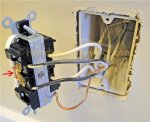TheColonel26
Member
- Location
- Battle Creek, MI
Receptacle Device Splicing: using the second terminal on a receptacle to continue the circuit to another receptacle instead of using a pigtail.
Is device splicing permissible under the NEC? If so is it considered a good practice? I ask because I was always taught to pigtail, and that device splicing was poor workmanship. however, I have never heard reference to anything in the code that actually prohibits it.
See attached image for example of what I mean.
Is device splicing permissible under the NEC? If so is it considered a good practice? I ask because I was always taught to pigtail, and that device splicing was poor workmanship. however, I have never heard reference to anything in the code that actually prohibits it.
See attached image for example of what I mean.


